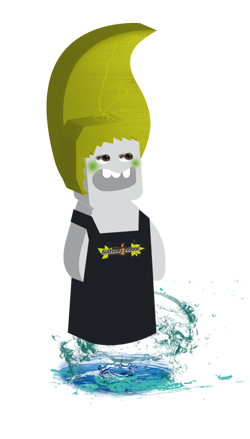LEXICON
*Hydroponics : Comes from the Greek, hydro = water, ponos = work. Hydroponics is an ancient technique that is the art of growing plants in water. Today, hydroponics is a term for growing plants without soil, on inert substrates. But different inert substrates imply different growing methods (commonly called soilless growing). There are different hydroponic systems*: drip*, aeroponics*, tidal tables*, NFT*.
*Systems: Refers to the containers of substrates or nutritive solutions that feed the plants. Each container works in a specific way.
*Aeroponics : Not to be confused with aquaponics, aeroponics is a technique of soilless culture. The principle of this type of cultivation is to spray a nutrient jet (in the form of mist) to create an oxygenated environment for the roots. In order to spray and not water the nutrient solution on the roots, it is necessary to have a pump that can develop a consequent pressure.
*Drip: The system consists of 2 tanks. The first tank contains the solution, the second contains the substrate (clay ball, coco...) and the plants. A pump, with water or air, brings the solution to the surface of the substrate. The solution flows through nozzles or a pierced ring. The solution, will thus water the roots and then fall back into the first tank, and so on.
*Tide table: The principle is to feed the plants continuously but they will be fed intermittently. Each watering cycle = 1 tide. Once the table is full and the substrate is sufficiently irrigated, the pump stops feeding the plant with solution and the solution can flow out through the drainage holes.
NFT* (Nutrient Film Technique): The NFT consists in making water circulate continuously at the foot of the rockwool cubes. The water that circulates continuously on this mat forms a nutrient film.
*CFL: Compact fluorescent lamps that provide exceptional luminosity and save up to 75% of electricity. They are energy efficient, last longer and require much less energy than traditional (or incandescent) bulbs to produce the same level of light intensity as traditional bulbs. They also produce little heat.
*Hygrometry: Refers to the relative humidity of the air. It is measured with a hygrometer.
*HPS: High Pressure Sodium (HPS) bulb. A HPS lamp does not work like a conventional incandescent lamp.
Requiring a particular intensity of current, the sodium bulb can not operate without a plate of adequate wattage (ballast). Its spectrum is ideal for flowering.
*MH : Metal Halide bulb. Its spectrum is ideal for vegetative growth.
*Ballast: A ballast must be adapted to the type and power required by the bulb. A ballast must be installed by a professional. It is a resistor that avoids overheating of the bulbs.
*Growing room: Cabinet made with innovative materials to protect the plant from external influences. Allows a better control of the environment of the plants.
*Reflector: The reflector reflects the light in an efficient and uniform way to concentrate it towards the plants.
*Substrate: A substrate is a material base that allows to receive an organic element, to ensure its durability or development. *Aquaponics: Aquaponics is the cultivation of plants in "symbiosis" with fish farming. The fish's excrements are used as fertilizer for the cultivated plants.
*Stabilized plants : Plants whose sap is replaced by a glycerine-based substance that is perfectly ecological and 100% biodegradable, allowing the plant to remain in its original state for many years without any particular maintenance.
*pH: Hydrogen potential, the pH measures the acidity or basicity of a solution.
*EC: Electroconductivity quantifies the richness and concentration of ions in the solution by measuring the conductivity of the solution (most nutrients absorbed by the plant are ions when they are in the soil and are ions in fertilizers dedicated to hydroponics).
*sMD led (abbreviation of Single Mounted Device): It is a SMD component (Surface Mounted Component), ie the component is directly soldered on the front of the printed circuit, there is no soldering on the outside of the printed circuit because the pins of the led do not pass through the printed circuit
 Good culture!
Good culture!
Find all our tips for your indoor culture:
- Indoor growing tips : Light
- Indoor growing tips : Air
- Indoor growing tips : The Substrate
- Growing tips for indoor plants : Water and fertilizers
- Growing tips for indoor plants : Germination and Cutting
- Growing tips for indoor plants : Growth
- Growing tips for indoor plants : Flowering
- Growing tips for indoor plants : The growing room
- Tips for indoor growing : Systems
- Growing tips for indoor plants : Water control
- Growing tips for indoor plants : Aquaponics
- Indoor growing tips : Accessories
The ability to gather all these elements in a partitioned space (a room or a growing room) determines the full success of a horticultural indoor growing.
Know how to plant without planting yourself!
Mister Hydro